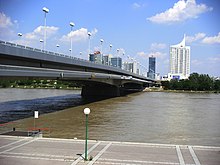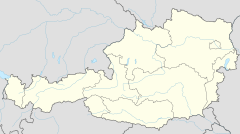Reichsbrücke
| Reichsbrücke | |
|---|---|

Reichsbrücke, seen from the right bank of the Danube
|
|
| Coordinates | 48°13′42″N 16°24′36″E / 48.22833°N 16.41000°ECoordinates: 48°13′42″N 16°24′36″E / 48.22833°N 16.41000°E |
| Carries | Light rail (tramway), road bridge |
| Crosses | Danube River |
| Locale | Vienna, Austria |
| Official name | Johann-Nestroy-Brücke |
| Maintained by | Stadt Wien (3rd bridge) |
| Preceded by | Reichsbrücke (1937) Reichsbrücke (1876) |
| Characteristics | |
| Design | haunched, hollow box cantilever bridge with double deck (3rd bridge) |
| Material | prestressed concrete (3rd bridge) |
| Total length | approximately 528 metres (1,732 ft) (3rd bridge) |
| History | |
| Construction begin | 1872 (1st bridge) 1934 (2nd bridge) 1978 (3rd bridge) |
| Construction end | 1872 (1st bridge) 1936 (2nd bridge) 1980 (3rd bridge) |
| Collapsed | 1976-08-01 (2nd bridge) |
The Reichsbrücke (German for Imperial Bridge) is Vienna's most famous bridge, linking Mexikoplatz in Leopoldstadt with the Donauinsel in Donaustadt on the other side of the Danube. It lies on an important axis leading from the city centre at Stephansplatz, through Praterstern, and on to Kagran in the north-east. The bridge carries six lanes of traffic, used by 50,000 vehicles daily, U-Bahn tracks, two footpaths, two cyclepaths and two utility tunnels.
The first bridge to be built on the site of the current Reichsbrücke was constructed in 1872–1876 under the name Kronprinz-Rudolph-Brücke (Crown Prince Rudolf Bridge), before the regulation of the Danube in Vienna. A truss of iron girders spanned the main river, with vaulted bridges crossing the flood plains on either side. It was formally opened on 21 August 1876, and the name was changed to Reichsbrücke in 1919 after Austria became a republic.
As a measure to reduce the level of unemployment in the 1930s, a suspension bridge was planned to take the place of the old Reichsbrücke. The technical plans were drawn up by the architects Siegfried Theiß and Hans Jaksch, with artistic control being given to Clemens Holzmeister. The pillars of the old bridge were extended downstream and the structure was shifted by 26 m in less than seven hours. The new bridge could thus be built on the line of the old bridge without long-lasting disruptions to traffic. This suspension bridge, built between 1934 and 1937, carried four lanes of traffic, two tram lines and footpaths on both sides. The bridges over the flood plains were also expanded. The new bridge was opened on 10 October 1937 by Cardinal Innitzer and Bundespräsident Wilhelm Miklas.
...
Wikipedia

